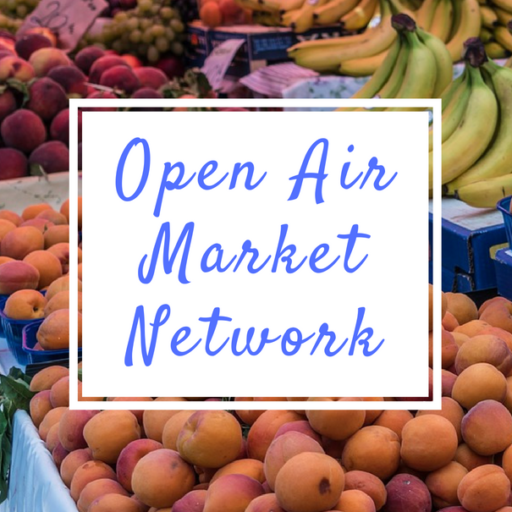Category: Uncategorized (page 2 of 3)
Bangkok, a city previously known for its renowned street food reputation, will no longer be a food destination of choice as the city launches a ‘clean-up’ effort, according to the New York Times. This past Tuesday, city officials confirmed their plan to eliminate all street vendors from the main roads.
While the removal of the delicious street-food vendors may seem like a loss, authorities agree that Bangkok must address the situation for “order and hygiene reasons,” in order to put the city back on track.
Read more about the Bangkok Street Vendor Market at: http://www.huffingtonpost.com/entry/bangkok-street-food-ban-vendors_us_58f5d5bbe4b0bb9638e60c15?ncid=inblnkushpmg00000009
Metrics + Indicators for Impact (MIFI), is a three-year research study carried out by a collaboration of the University of Wisconsin-Madison and the Farmer’s Market Coalition. Funded by the USDA’s Agriculture and Food Research Initiative (AFRI), MIFI strives to create a user-friendly database that measures and collects information from farmer’s markets across the country. The database encourages its national farmer’s market participants to collect data in an organized and timely fashion, allowing the information to be used in an efficient and helpful way for future participants and vendors. The MIFI portal measures the economic, social, and ecological impacts within the participating national markets. Examples of the information collected are the average numbers of visitors to markets, total market sales, transportation methods to the markets, etc. According to the MIFI markets website (mifimarkets.org), farmer’s markets can use this resource in order to understand their role in fostering social interaction and local economic development, improve internal decision-making and strategic planning, and strengthen relationships with community partners, sponsors, vendors and customers.
MIFI member, Dusty Krikau, from the Fon du Lac Farmer’s Market explained his experience with the online resource. Krikau said, “Metrics + Indicators for Impact has given us access to valid and reliable statistical analysis of our market – something that would be unrealistic on our standard operating budget…The insights gained have helped us write grant requests and reports; recognize areas where we can make quick and easy improvements; and respond to concerns from customers, vendors, and local business owners.”
Principal Investigator, Professor Alfonso Morales believes that a systemized program like the MIFI market system will “help bring an evaluation feedback loop that is often missing in many farmer’s markets, enhancing market credibility which will enable more effective decision-making.” After years of dedication since the start of the MIFI grant in April 2014, Morales and his team have come to the end of their journey as the new website plans to launch this May with the goal that the online tool will strengthen national food system networks.
For more information, go to: mifimarkets.org
The push to legalize sidewalk vending in the City of Angels moved closer to its goal. Last week the Los Angeles City Council adopted a motion approving in concept legalization and regulation of street vending. The motion directs the City Attorney to draft an ordinance to decriminalize vending and authorizing the board of public works to issue permits for stationary sidewalk vending in commercial and industrial zones, with a maximum of two vendors per block face, and limited mobile vending in residential zones.
The approach is not perfect. The two vendor per block face limit seems arbitrary. It is doubtful that the City would consider limiting storefront retail businesses to two per block face in commercial zones. Concerns about sidewalk congestion can and should be addressed with less ham-handed approaches.
Despite blemishes, this is an important step. It has been more than 20 years since the City Council last took action toward legalizing sidewalk vending. That last effort resulted in an ordinance that made possible the creation of legal vending districts. The process to do so was so complex and choked with red-tape, though, that only one district was ever created. It could never accommodate all the vendors (and their many customers) who wanted to participate, and fizzled out after a few years of operation.
By starting with the premise that the entire City should be open to sidewalk vending, the City Council’s action holds the promise of success.
Networks similar to Open Air strive to create forums and spaces where people with the shared interest of farmers’ markets are able to come together and exchange ideas. Each year, Maine Federation of Farmers’ Market (MFFM) holds an annual conference, inviting inspiring and influential people to come educate those involved in the federation. University of Wisconsin-Madison Professor and member of Open Air Market Network, Alfonso Morales, was one of the many attendees of the conference. While there, Morales gave a presentation titled, “Resurgent Farmers’ Markets: Impacts Around the US and Prospects for Maine” to over 125 guests. Here are some photo’s from Alfonso’s trip this past weekend:
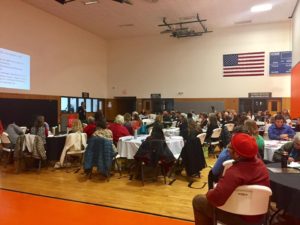
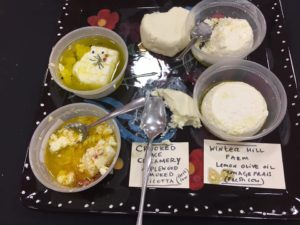
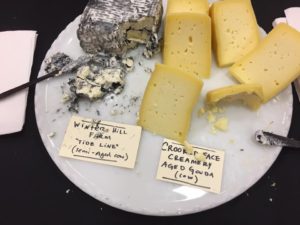
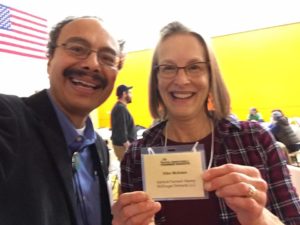

I remember the first time I came to Madison, Wisconsin. The true beauty of the city immediately stood out between the Capitol Building and the two lakes. I stood looking up State Street, awestruck by the city I was about to call my home for four years. Amongst the many highlights that Madison has to offer, one of the features of the city that caught my eye most were the many food trucks lined up on Library Mall.
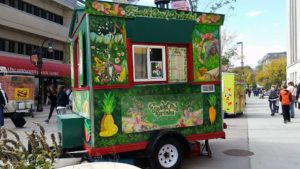
Food Trucks on Library Mall in Madison, Wisconsin.
In a state that prides itself for beer and cheese, the diversity of ethnicities amongst the food trucks is incredible. Whether you are craving authentic tacos, Chicago-style hot dogs, or Thai food, you are able to get any of them for just a few dollars. Now, four years later I am striving to complete the ‘rounds’ and eat at every food truck that holds a residency in Library Mall.
While hoping to try each truck before graduating this May, there are a few that I must say are my favorite. This anecdote will tell you why.
My curiosity continued to grow as I watched the line for the green food truck titled, “Fresh Cool Drinks” wrap around Library Mall like a never-ending snake. My mind immediately wondered, what’s so good about this truck? Little did I know, not only is the food my favorite, but also the worker, Tsuey.
Fresh Cool Drinks has, in some sense, saved my life while studying on campus. Although the line is often incredibly long, it is always worth the wait. The cart’s most popular, and my favorite food cart item, is the $3 spring roll. Tsuey fills each roll with an overwhelming amount of ingredients like cabbage, a choice of meat or tofu, avocado and a choice of sauce. Never did I think I could fall in love with a food item, but I did.
Tsuey has a huge influence on her costumers, as she tends to remember the faces and names of her regulars – making each visit at the truck a memorable one.
Amidst the flu and final season of December 2016, I stood in the long line for a spring roll. After fighting off strep throat for a few days, my voice was cracked and quite noticeable. Immediately after I ordered my lunch, Tsuey asked if I was sick and what my symptoms were – her concern was heartwarming.
Within minutes, Tsuey popped her head out of the window with my spring roll and before I could say thank you, she then handed me a soothing home remedy for my throat consisting of ginger, honey and lemon and instantly said, “on the house.”
Tsuey’s act of kindness instantly triggered a feeling of comfort and home in this city. The food trucks are a place for people to explore the many cultures of Madison while simultaneously radiating happiness and common ground for everyone. If given the opportunity, check out a truck that you have not yet been to – the food, as well as the people working may surprise you.
By Lisa Lucas, Associate Research Specialist for Metrics + Indicators for Impact, University of Wisconsin–Madison
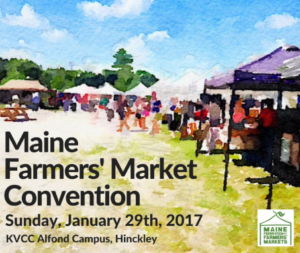 I was very excited to be able to attend and present at the Maine Federation of Farmers’ Markets (MFFM) 2017 Annual Convention yesterday, January 29. The convention was held at Kennebec Valley Community College–Alfond Campus north of Waterville, Maine. I was invited to attend along with my supervisor, Dr. Alfonso Morales of the University of Wisconsin–Madison, by MFFM’s Executive Director Leigh Hallett, whom we worked with on a project this past year.
I was very excited to be able to attend and present at the Maine Federation of Farmers’ Markets (MFFM) 2017 Annual Convention yesterday, January 29. The convention was held at Kennebec Valley Community College–Alfond Campus north of Waterville, Maine. I was invited to attend along with my supervisor, Dr. Alfonso Morales of the University of Wisconsin–Madison, by MFFM’s Executive Director Leigh Hallett, whom we worked with on a project this past year.
I loved being back in Maine. I lived in Maine briefly in 2010 before starting graduate school in New Hampshire, and my sister lived in Portland, Maine for six years before recently moving to Los Angeles. Maine is a gorgeous state! I stayed in Portland this past weekend, and enjoyed the scenic hour or so drive up to Waterville to attend the convention. Maine winters are cold, but very bright; it was nice to see sun again having come from overcast Wisconsin. But, I’ve digressed…
Alfonso was invited to give the keynote address to the over 125 market managers, farmers, and vendors from all over the state of Maine who attended; his presentation was titled “Resurgent Farmers’ Markets: Impacts Around the US and Prospects for Maine.” The gym where he presented was packed and his talk was well-received. Alfonso even packed several prizes from Wisconsin to distribute to lucky winners after his talk; how fun!

Alfonso Morales giving his keynote to a packed gym.
The schedule of the day included 13 different workshops attendees could choose from. I attended bits and pieces of several, but especially enjoyed the lively discussion in “Keep the Peace: Dealing with Difficult People on Both Sides of the Tent.” Vendors in this session shared their experiences and expertise in handling difficult vendor-vendor and vendor-customer situations. There were nods and laughs of agreement at some of the colorful stories shared!
After a delicious lunch and MFFM’s annual meeting, I presented with Leigh on data collection. Leigh discussed the results of the MFFM Snapshot Week surveys that her team distributed to shoppers at farmers markets throughout Maine last summer; they received over 2000 responses. The findings from the surveys informed the creation of MFFM’s recently published 2016 annual report which was distributed to legislators and the general public earlier this year. Among other things, the surveys showed that not only do Maine farmers market shoppers spend money at the markets they attend, they also spend an average of $20 at neighboring businesses too. Maine farmers markets are helping local economies. The Snapshot surveys also included a wealth of qualitative feedback; shoppers shared their favorite market memories and the reasons they keep coming back to their local markets. Leigh’s talk on the interesting things that data can show us was a perfect segue into my presentation on a specific data collection tool soon-to-be-available to farmers markets nationwide.
I was excited to share about Metrics + Indicators for Impact (MIFI), a comprehensive data collection, interpretation, and reporting toolkit and online portal developed by Dr. Morales and PhD candidate, Lauren Suerth, also of UW–Madison. I came to the project several months ago as a part-time project coordinator/customer service liaison supporting the work. MIFI (pronounced like “wi-fi”) is currently being pilot-tested by over 20 markets across the country. MIFI empowers markets to take data collection into their own hands. MIFI provides all the tools, directions, and support that markets will need to successfully collect data on their markets, and then an online data portal crunches the numbers behind-the-scenes. No need to hire a statistician! MIFI will be available to markets nationwide this spring, so more to come on that later.
I was very appreciative of the opportunity to travel to Maine from Janesville, Wisconsin (where I now live) to learn more about farmers markets and be able to share about MIFI, the project I’ve been working on. Thank you, Leigh! The only thing I forgot to do was grab a “lobstah” roll while I was there. Next time! (For more pictures of the event, check out the Open Air Facebook page.)
by Madeleine Jones, Agricultural and Applied Economics Undergraduate Student at University of Wisconsin-Madison
Our last stop in Spain was Madrid, where I visited the Mercado de Antón Martín. The Mercado de Antón Martín is located in the bohemian district of Huertas, bordering the immigrant barrio of Lavapiés. The Mercado de Antón Martín has been open since 1941, and it is one of the most traditional markets in the city. It is tucked away in an alley, bordered on both sides by artisan cafes, bars, and butcher shops. The market has a bit of an indie vibe, which echoes that of the neighborhood it is in.
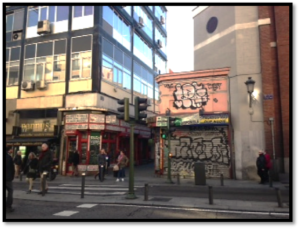
The Mercado de Antón Martín is tucked in between Calle de Santa Isabel and Calle de Atocha in the bohemian district of Huertas, bordering the immigrant barrio of Lavapiés.
A few carts line the outside of the building, but most of the market’s 63 stalls are inside of the two-story establishment. They tout an astonishing variety of wares: clothing, meats, produce, herbs, wine, packaged foods, regional specialties (e.g., Iberian ham), and more. Organic food stalls, wine bars, and a craft beer shop emphasize the hipster feel, and there is even a space for cooking demonstrations and small art exhibits.

A few stalls line the outside of the Mercado de Antón Martín, but most of the market’s 63 stalls are inside the two-story establishment.
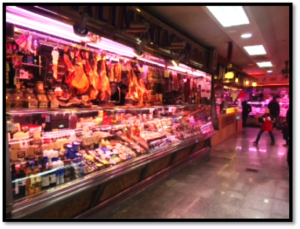
The Mercado de Antón Martín offers an astonishing variety of goods including regional specialties like Iberian ham, as seen hanging from the top of this stall.
The Mercado de Anton Martín’s success is partly due to the fact that vendors are highly attuned to their customers’ demands. A recent influx of high-income professionals who prefer high-quality organic products has profited the market. New vendors have moved into the market in response to the demands of these shoppers, offering high-quality gourmet items such as Yoko, a vendor offering Japanese carryout food. Some of the vendors have expressed interest in adding more specialized offerings like natural, fresh-squeezed juices. However, current city ordinances governing municipal markets prevent this. I did see a smoothie bar at the market, and it seems vendors are doing their best to capitalize on market trends, even if they cannot take advantage of the “juicing” craze. Overall, there are marked attempts to satisfy the tastes of emerging and increasingly dominant consumer groups like young people and tourists. A further attempt to draw in homesick tourists is exemplified in shops like Best of Britain, which sells products like Heinz baked beans and offers language learning events.
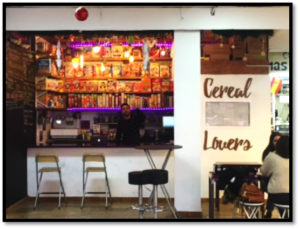
Vendors are highly attuned to the demands of tourists and young consumers, as demonstrated by specialty shops catering to these demographics like “Cereal Lovers.”
Tourists are not the only ones who frequent the Mercado de Antón Martín. Immigrants comprise another important market segment, especially Latin American buyers. In particular, vendors make a special effort to cater to Ecuadorian tastes, and just last year, two new Ecuadorian produce vendors established themselves in the market. Thanks to these establishments, shoppers can buy yuca, plátano macho verde (green bananas), and maíz para tostar (toasting corn).

Fresh produce remains an important category in the market. Regional produce vendors offer goods from abroad (especially South America) to tap into the immigrant market.
Lastly, the Municipal Market of Antón Martín continues to maintain its traditional lifelong client base. This segment consists of women over 65 who almost daily go to the market to buy produce. In many cases, the vendors have known these clients for 20 years or more, and have a jovial and personal relationship with them. As one merchant puts it, “They are old people who, sometimes do not need anything but come to see you.”
Visiting Spain was truly a vibrant cultural experience, and visiting the marketplaces there gave me a much better sense of the traditions, current trends, cultural values, and of course, culinary offerings that make Spain what it is!
by Madeleine Jones, Agricultural and Applied Economics Undergraduate Student at University of Wisconsin-Madison
Over the past eleven days, I had the chance to visit Spain with my family. In between enjoying tapas, museums, and touring, I explored some of the informal marketplaces in the different regions I toured. Over the course of my trip, I encountered an astounding array of markets—from farmers’ markets and fruit vendors, to gourmet food markets offering sushi and cocktails, to emigrant manteros selling their wares off bedsheets. In the following post, I will try to give you a small taste of the thriving vendor culture that I experienced while in Spain.
First, some quick background on marketplaces and vendors in Spain. It is estimated that there are between 3,500 and 4,000 street markets in Spain, creating some 50,000 jobs. These markets are located mainly in Andalucía, Valenciana, and Cataluña, and are dominated by a few main sectors: textiles, food, footwear, crafts and home equipment. Street vending has long served as a gateway into the labor market for people with little education or training. The lack of street vending regulation in Spain has contributed to the popular belief that the government allowed the activity as a social service to the vendors. However, studies have shown that it is in fact the street vendors who benefit society by providing goods to less-populated areas of Spain and enhancing rural development.
Now, back to the action! My family and I flew into Madrid Barajas International Airport, and spent the first part of our trip in Mijas, a town in Málaga, Andalusia. Located on the southeastern coast of Spain, Mijas offers stunning sea views and an easy trip into Fuengirola, a beach town on the Costa del Sol Málaga. In Fuengirola, there were many vendors selling trinkets, clothing items, and counterfeit goods, on a bedsheet—a practice called top manta. I saw this trend replicated in Granada later in the trip, and I read about the practice in a Fortune.com article titled “Counterfeit sidewalk vendors in Spain try to go legit”. The article chronicles a Senegalese-Spanish emigrant’s quest to form a worker’s union, establishing the validity of his trade. However, at least in Fuengirola, the police force is cracking down.

The sea view from our house in Mijas on the southeast coast of Spain.
A celebrated example of the market culture in Fuengirola is La Galería Gastromarcado, which opened in early February last year and is located in the heart of the city. This upscale market boasts twelve booths and a bar, and many of the vendors are clearly aimed at capturing the tourist market with hip offerings like sushi and cocktails. However, others, like Tierra Mía, strive to retain an authentic character in their dishes. They offer traditional Spanish fare with a creative twist. For example, their menu selections include fabada, a hearty stew from the mountains of Asturias in northern Spain, rabo de toro, a traditional Cordoban stew made with the tail of a cow or bull, and paella, Valencian rice dish. This past April, La Galería proudly attended the First Meeting of Markets of Spain (el I Encuentro de Mercados de España) in Cordoba, which brought together representatives from 24 gourmet markets throughout the country.

Fuengirola, a beach town on the Costa del Sol Málaga.
